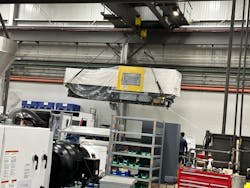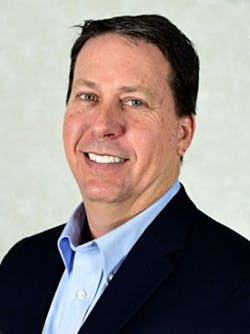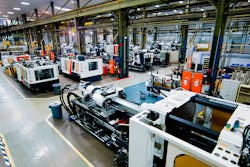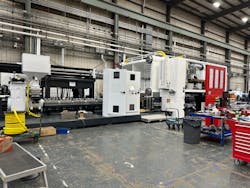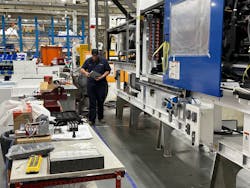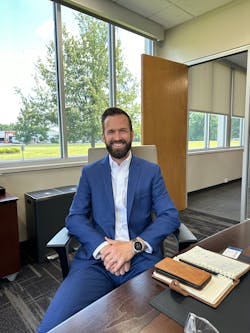Focus on efficiency guides Milacron
By Ron Shinn
The sprawling facility produces injection molding and extrusion machines.
Most are IMMs — a mixture of all-electrics, hydraulics, servo hydraulics and low-pressure injection molding machines — and the others are extrusion machines. The extrusion machines are conical twin-screw, parallel twin-screw and single-screw designs.
The company, which also produces injection molding and extrusion machines at a plant in India, has been building plastics processing equipment for more than 50 years and has a huge number in operation worldwide. With its sister companies Mold-Masters (hot runners and thermal controls) and DME Company (mold components and MRO), Milacron provides auxiliary equipment including robots, conveyors, granulators, and equipment for materials handling, heat transfer and mold handling.
Despite labor shortages and lingering supply chain problems affecting manufacturing plants worldwide, the Batavia plant consistently has a high on-time delivery rate.
The company attributes a big part of that performance to improvements made during the COVID period as well as changes implemented by parent company Hillenbrand, which purchased Milacron for $2 billion in 2019.
“It made us rethink some of the things we were doing from a domestic and global output perspective,” said Andy Stirn, GM for Advanced Systems, referring to the labor and supply chain issues during COVID. “The productivity enhancements and just the rethinking of some of our manufacturing practices, along with the Hillenbrand Operating Model, has definitely moved the needle for us. We are now a lot more lean and efficient.”
The Hillenbrand Operating Model (HOM) consists of four steps: understand your business, focus on the critical few priorities to align vision and focus resources throughout the organization, execute the plan, and grow for the future.
The Batavia plant floor is well organized with wide aisles and large assembly stations, a necessity when moving large machines in and out. It's home to 92 different cranes, the largest of which hovers overhead with a capacity of 60 tons.
Every shift starts at an S – Q – D – C status board where issues with safety, quality, delivery and customer are logged and discussed. Items that cannot be corrected in a few hours are sent to a higher-level group for action. This process, part of the HOM, has reduced the amount of time it takes Milacron to build machines.
Another interesting concept of the HOM is the Value Stream leader, which replaced a traditional plant manager position. There are Value Stream leaders for injection machines and extrusion machines.
“The goal of incorporating Value Streams is to maximize customer satisfaction and minimize waste. A Value Stream structure aligns the organization and its resources to the steps that create value for the customer,” Jones said. “It is focused on optimizing the activities that add value and aligns those activities, people, systems, materials and information flow to the value proposition of the business.
“Each Value Stream within our facility has a laser focus on a product line. This focus ensures that the product is manufactured with complete clarity for the manufacturing team that holds customer expectations as their guiding beacon.”
The Value Stream concept is a critical component of the HOM that was integrated into Milacron operations in 2021, Jones said.
Hillenbrand’s Molding Technology Solutions (MTS) operating segment, which includes Milacron, Mold-Masters and DME, had $260 million in revenue during the fiscal-year second quarter, which ended March 31, 2023. This was up 4 percent over the same quarter a year ago. Hillenbrand said in its quarterly report that the improved performance was due to increased sales of injection molding equipment, favorable pricing and higher sales of aftermarket parts and service.
Stirn said Milacron focuses on developing equipment to improve processor efficiency. “Our customers are competing against other processors. A pail customer is competing against another customer molding pails and needs to have an advantage to win over his competitor,” he said.
The company, which employs about 1,800 people globally, said it has long-standing relationships with 27,000 customers worldwide.
“From the machine technology standpoint, what can we do to improve a customer’s efficiency to make him more competitive? That really is a big part of what we look at,” Stirn said. “Sometimes you get into the weeds, but ultimately it’s about making our customer more competitive in the market.”
The machine that works for molding pails does not necessarily work for molding medical parts. “It’s a completely separate mousetrap,” he said.
“You cannot just visit one customer and understand this market,” Stirn said. “You have to understand it from a variety of perspectives. Within the medical industry, there are a lot of sub-segments. You’ve got very narrow lanes in medical machines. Each need their own features to be super-competitive, and I think we do a good job of understanding that.”
Even though Milacron builds plenty of specialized molding machines, Stirn said it can still compete with lower-priced, general-purpose machines.
“Our Q series is a great fit for that market. We can add technology or bolt on technology to that platform when we need to. It is a very value-based machine. It is a very efficient machine,” he said. “Because of the enhancements we can make to the Q series, we are able to design a machine that meets customer specifications and at a very competitive price in the market.”
“We saw a big demand spike in that in the late-2017-to-2019 time frame,” Stirn said. “But COVID really brought it to another level. There is so much talent leaving the industry, and customers are relying more on auxiliaries and integrated systems.”
Joel Neller, director of assembly operations for North America, agreed. “COVID caused a lot of knowledge to leave our customers’ plants. Our customers came to us as a supplier and said, ‘We want to write one check. We want everything there. We want you to be the strategic partner for us.’ “
“Automation growth has been a trend in plastics processing for some time,” Jones said. “Our industry continues to see a declining qualified labor pool in the skilled trades through attrition and availability. As a manufacturer, it’s a requirement to offer auxiliary equipment that meets the needs of the customers across the plastics processing value chain,” he said.
Sustainability will play a bigger role in plastics processing machinery in the future, and Stirn said Milacron is well-positioned to take advantage of the trend.
“Going back to 2000, we put energy-monitoring devices and equipment on our machines, and no one cared,” Stirn said. “But now, everything about energy, sustainability, recycling, bio-resins — all of that now is in play. It can make or break a big order.
“I think we have some excellent designs on our all-electric and servo-hydraulic machines. We have some very energy-efficient equipment, and we probably don’t get enough credit for that,” he said.
Machine technology related to co-injection and processing post-consumer recycled resins has also been a focus, Stirn said. “We feel like we are doing our share of developing the right screws and barrels to handle those resins, working with tooling automation, trying to take a hard look at some of these single-use applications and determining what can be done with bio-resins,” he said.
Before Industry 4.0 and IIoT (Industrial Internet of Things) were well-known buzzwords, Milacron developed its M-Powered system that connects individual processing machines to a Milacron cloud portal. It has become a major advantage for the company.
“I think it is a huge advantage for us,” Stirn said. “We’ve been doing it successfully for eight years now, and it is a great tool.”
M-Powered is a portfolio of observational, analytical and support services. Based upon machine settings and predictive algorithms, M-Powered monitors machine performance and alerts the operator to current issues and potential issues that might arise in the future.
This Milacron-exclusive control solution has been pre-wired into every molding machine since 2015. M-Powered is now being expanded to include peripheral equipment as well.
Niiko Rautiola, VP of aftermarket for Milacron, said technicians in Batavia can log into an M-Powered molding machine anywhere and troubleshoot problems. If a problem cannot be fixed remotely, then the technician sent to the plant already has diagnostic information and spare parts he or she will need to make the repair on-site.
The company maintains a huge warehouse of aftermarket and replacement parts in Batavia, India and Germany. Rautiola said the goal is to maintain parts for machines up to about 30 years old.
Milacron is starting to use data from M-Powered machines to determine what could go wrong. “The goal of aftermarket going forward is to be more proactive,” Rautiola said.
“The minute they call us, we act quickly to get a machine back up and running, we are going to do it. We do it 24/7, 365 days,” he said. “But we are trying to shift that focus more towards a preventive approach, getting our technicians into our customers’ facilities, looking at their machines and providing them with free assessments right off the bat.”
“We can provide them with solutions, whether they have their own in-house technical team that we can support or we can have our team go in and actually do the work for them.”
Due to high cost, fewer Milacron machine owners opt for complete rebuilds nowadays. But Milacron still does brisk business in component rebuilds. “Through a rebuild, we are able to go back and retool a component or potentially provide the customer with new technology that they did not have when they purchased the machine,” Rautiola said. Control retrofits are a frequent request from companies that want to standardize all of the control interfaces in their plants.
Jones said he sees large-scale growth opportunities globally, but he declined to list specific regions that Milacron has targeted for the strongest growth. “Our manufacturing and sales and service centers are ideally placed to capture the growing markets,” he said. “Our product lines have been optimized for each region to provide the technology required for our customers to succeed.”
But he is cautious about the next 18 months. “The plastics processing industry, among many others, is currently being impacted by growing macro-economic concerns and geopolitical challenges. Interest rate hikes, credit tightening and global economic uncertainty are all contributing factors that influence decision-making and investment,” he said. “We remain cautious in our outlook.”
Ron Shinn, editor
[email protected]
Contact:
Milacron, Batavia, Ohio, 513-536-2000, www.milacron.com
About the Author
Ron Shinn
Editor
Editor Ron Shinn is a co-founder of Plastics Machinery & Manufacturing and has been covering the plastics industry for more than 35 years. He leads the editorial team, directs coverage and sets the editorial calendar. He also writes features, including the Talking Points column and On the Factory Floor, and covers recycling and sustainability for PMM and Plastics Recycling.
